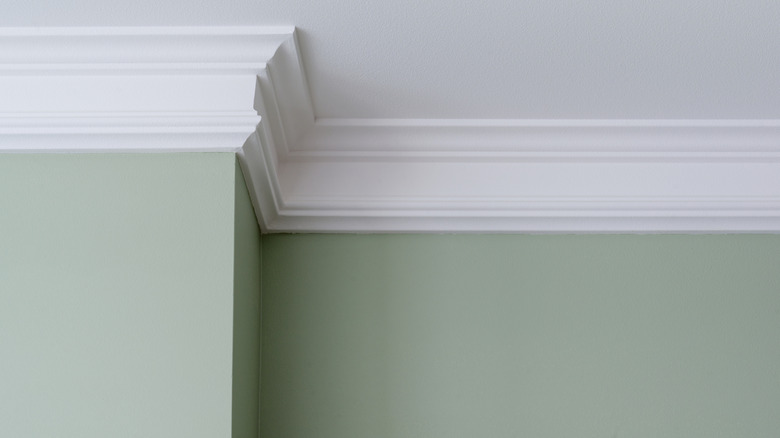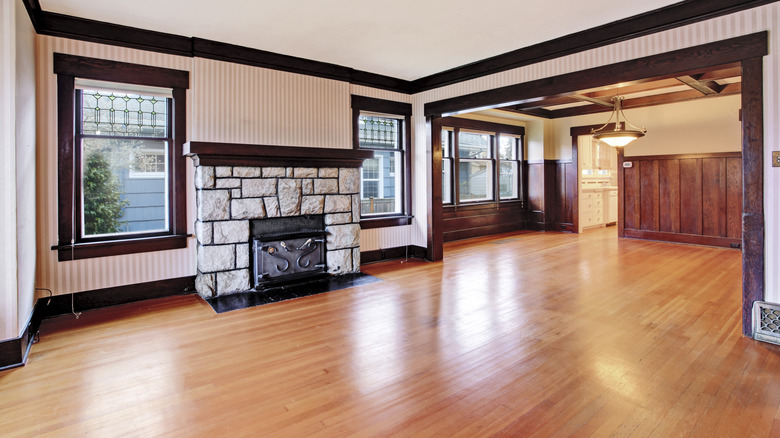Using These Paint Colors To Update Your Trim Could Be A Big Mistake
Paint is a tried and true way to update or personalize the design scheme in your space, and updating your trim is a budget-friendly paint job that can totally transform your home. Layering just the right shade of your chosen colors together will have a defining quality in your aesthetic. Stark, contrasting colors will highlight each element, while softer, more complementary hues will blend more seamlessly. Ultimately, of course, there isn't any one right color to paint the trim in your home. But there are a few colors — or variations thereof — that might be best to avoid. Certain shades of white, dark hues, and even painting everything the same color may not be great options for you, depending on your space, your needs, and your style.
Before you decide to update the look of your home by giving your trim a refresh, consider the style you want to create. Mixing bold trim with more neutral walls will give you a more eclectic, high energy effect while keeping both walls and trim in the neutral zone will provide a more tranquil look. Additionally, you'll want to consider the finish, or sheen, of your paint choice. Some are more durable than others and can even be used to enhance your design. So what are the trim colors you might want to avoid? The answers might surprise you.
White trim isn't foolproof
Be wary of white. Yes, clean white trim is a classic. But it's also a capricious, highly nuanced shade. Anyone who has spent time in the world of art, design, or decor knows that one of the many complicating factors of using white is that there is no one white. Some have yellow undertones, others have hints of blue or gray. Certain whites might clash with the rest of the space, rather than complement it. Yellow toned whites, for example, can be aesthetic danger zones. Depending on the temperature of the lighting in your space, a lot of blue light shining on a yellow-ish white wall can easily come off more green than clean.
Even if you go for a really white, white, you might be facing some challenges. Pure white can feel stark and even anemic, especially in a home where warmer undertones rule the walls in the rest of the house. Traces of brown, orange, or red in the color may come off looking dirty if they're surrounded by a harsh white. Additionally, and perhaps obviously, white shows everything. So it might take some extra work to keep your trim looking fresh and polished.
Dark colors may not be great choices for trim
On the other hand, very dark colors are not necessarily in the safe zone either. While painting your trim a rich color might be the interior paint trend that will be replacing outdated white trim, that doesn't mean there aren't considerations to take. Deep colors can fade faster than lighter colors, so there may be additional maintenance involved. Also, while dark colors are quite popular right now, they may not be in the future. Neither will they appeal to everyone. So if you're considering selling your property, it might be worth side-stepping the ultra-dark colors. The same could be true of monochrome color schemes, and part of the reason they may not be the best alternative to dated white trim either. What's more, that lack of dimension can make your space appear expressionless and flat.
However, working with highly curated color combinations and finishes can help steer you toward success. Indeed — dramatic, complementary color combinations will do wonders for highlighting interesting architecture or design elements. What's more, working with the sheen of your paint choices can help to create interest and dimension, even while sticking with more monochromatic color choices. A very high gloss trim, for instance, will definitely stand out against a matte finish on a wall of the same color. Bear in mind, however, that the lower the sheen, the lower the durability — so you'll likely want to stick to at least a satin finish on your trim work.


